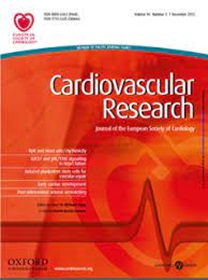Interleukin-37 attenuates aortic valve lesions by inhibiting m6A-mediated IRAK-M degradation
IF 10.2
1区 医学
Q1 CARDIAC & CARDIOVASCULAR SYSTEMS
引用次数: 0
Abstract
Aims Calcific aortic valve disease (CAVD) has become an increasingly important global medical problem without effective pharmacological intervention. Accumulating evidence indicates that aortic valve calcification is driven by inflammation. Interleukin-1 receptor-associated kinase M (IRAK-M) is a well-known negative regulator of inflammation, but its role in CAVD remains unclear. Methods and Results Here, we stimulated aortic valve interstitial cells (AVICs) with low-dose lipopolysaccharide (LPS) to mimic the inflammatory response in aortic valve calcification and observed the expression pattern of IRAK-M. Furthermore, we generated IRAK-M-/- mice to explore the effect of IRAK-M deficiency on the aortic valve in vivo. Additionally, overexpression and knockdown experiments were performed to verify the role of IRAK-M in AVICs. MeRIP‒qPCR was used to detect the N6-methyladenosine (m6A) level of IRAK-M, and recombinant interleukin (IL)-37-treated AVICs were used to determine the regulatory relationship between IL-37 and IRAK-M. We found that IRAK-M expression was upregulated in the early stages of inflammation as part of a negative feedback mechanism to modulate the immune response. However, persistent inflammation increased overall m6A levels, ultimately leading to reduced IRAK-M expression. In vivo, IRAK-M-/- mice exhibited a propensity for aortic valve thickening and calcification. Overexpression and knockdown experiments showed that IRAK-M inhibited inflammation and osteogenic responses in AVICs. In addition, IL-37 restored IRAK-M expression by inhibiting m6A-mediated IRAK-M degradation to suppress inflammation and aortic valve calcification. Conclusions Our findings confirm that inflammation and epigenetic modifications synergistically regulate IRAK-M expression. Moreover, IRAK-M represents a potential target for mitigating aortic valve calcification. Meanwhile, IL-37 exhibited inhibitory effects on CAVD development both in vivo and in vitro, giving us hope that CAVD can be treated with drugs rather than surgery.求助全文
约1分钟内获得全文
求助全文
来源期刊

Cardiovascular Research
医学-心血管系统
CiteScore
21.50
自引率
3.70%
发文量
547
审稿时长
1 months
期刊介绍:
Cardiovascular Research
Journal Overview:
International journal of the European Society of Cardiology
Focuses on basic and translational research in cardiology and cardiovascular biology
Aims to enhance insight into cardiovascular disease mechanisms and innovation prospects
Submission Criteria:
Welcomes papers covering molecular, sub-cellular, cellular, organ, and organism levels
Accepts clinical proof-of-concept and translational studies
Manuscripts expected to provide significant contribution to cardiovascular biology and diseases
 求助内容:
求助内容: 应助结果提醒方式:
应助结果提醒方式:


